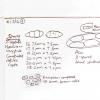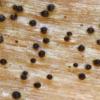
21-12-2025 09:32
Hello.A tiny ascomycete found embedded in wood in

22-12-2025 00:47
Patrice TANCHAUDBonsoir, récolte à proximité du milieu dunaire

21-12-2025 21:32
Pol DebaenstHello, Garden, Burgweg 19, Veurne, BelgiumOn 10/1

21-12-2025 21:40
Isabelle CharissouBonjour, j'aimerais connaitre les références de

21-12-2025 21:31
Pol DebaenstHello, Garden, Burgweg 19, Veurne, BelgiumOn 10/1

21-12-2025 21:31
Pol DebaenstHello, Garden, Burgweg 19, Veurne, BelgiumOn 10/1

20-12-2025 23:08
Patrice TANCHAUDBonsoir, récolte sur sol sablonneux dans l'arri�

20-12-2025 15:47
Mirek GrycHi.These grew on pine wood that was heavily covere
Pyrenomycete Resembling Leptosphaeria on Sambucus
Peter Thompson,
14-03-2016 12:48
I have a sample of many individual, erumpent, black fruit bodies on a decorticated branch of Sambucus nigra. Macroscopically and microscopically they seem to most closely resemble the genus Leptosphaeria, but hardly any species grow on wood.
The spores were hyaline or very pale and becoming 3-septate, even in the ascus and constricted at the septa. Less mature spores had only a few small drops and faint septa developing.
There was no reaction at the ascus tip to Melzers.
I have attached a photo of the fruit bodies and a sketch of the microscopy and wonder if anyone has any ideas.
Thank you,
With Best Wishes,
Peter.
Gernot Friebes,
14-03-2016 15:42
Re : Pyrenomycete Resembling Leptosphaeria on Sambucus
Hi Peter,
my initial thought would be Exarmidium, a curious genus that's been discussed many times on this forum.
Best wishes,
Gernot
my initial thought would be Exarmidium, a curious genus that's been discussed many times on this forum.
Best wishes,
Gernot
Peter Thompson,
14-03-2016 15:49
Re : Pyrenomycete Resembling Leptosphaeria on Sambucus
Hello Gernot,
Thank you for that information.
It is a new genus for me, so I will have a look through the previous discussions and any documentation which might be referred to in them.
**** I have now looked into the previous Ascofrance forum postings and Zotto Baral's Cubby data and I am satisfied that my sample is indeed Exarmidium inclusum. There are previous British records for this species in both national databases, unlike most species in the genus.
Thank you,
With Best Wishes,
Peter.
Thank you for that information.
It is a new genus for me, so I will have a look through the previous discussions and any documentation which might be referred to in them.
**** I have now looked into the previous Ascofrance forum postings and Zotto Baral's Cubby data and I am satisfied that my sample is indeed Exarmidium inclusum. There are previous British records for this species in both national databases, unlike most species in the genus.
Thank you,
With Best Wishes,
Peter.


